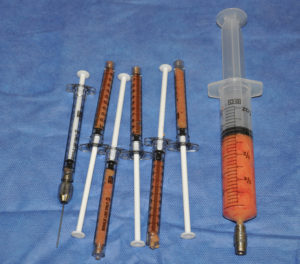
Fat grafting is not the equivalent of typical injectable fillers. Instead, it is less stiff and behaves more like a liquid. ¦It has little substantative pushing effect on a specific tissue site. That is why if you try and use injected fat to lift up or diminish a fold or wrinkle, it does not work very well. Regardless of whether it even survives, it does not have a focused displacement effect. For areas that are very adherent, such as deep creases, folds, and lines, it just can not efface them. These commonly perceived areas of fat injections have high failure rates and that experience contributed to the perception that injected fat doesn’t work very well. Fat injections are best used as a volume fillers for the treatment of facial contour areas.
The biggest reason that fat grafting has become more accepted today is technology. Advances in harvest methods and processing (concentration) are the two main areas of improvement. Less traumatic harvesting methods that enable better quality fat to be obtained creates fat tissue that even looks better. Getting rid of extraneous liquids and debris, whether it be centrifugation or less powered purification methods, creates a more homogenous injectate material.
But the one thing that has really tipped the balance to wider acceptance and usage is that of stem cells. The realization that high concentrations of stem cells reside in fat has raised the potential that they can be used for better volume preservation and even promote healing in difficult wounds. The stem cell has been given magical properties even though whether it really has any benefit to a fat injection is far from an established medical fact. Many anectodal claims are being made about skin quality improvement and anti-aging tissue effects. While the science has yet to provide proven support of these observations, the potential of it has propelled injectable fat transplantation into one of the hottest topics in all of plastic surgery today. Once scourned and held in disrepute by most plastic surgeons, fat grafting today has undergone a complete reversal of medical acceptance…and the well known stem cell is helping it along.
In performing fat injections into the face and hands, I have observed some changes in the quality of the skin overlying grafted fat. Sun-damaged and aging skin seems to improve in some patients (I didn’t say all patients) more than one would anticipate just from the push of the volume from the fat under the skin alone. This newly injected fat appears to be contributing to improved healing into the areas where it is injected. From breast lumpectomy defects to facial scars, there does appear to be some healing benefits. Research suggests that these positive effects on the skin may be from exogenous factors from stem cells. Since fat has the greatest number of stem cells of any tissue in the adult human body, their potential influence is likely. The presumed effect is that they promote earlier and more abundant blood vessel growth into the surrounding and overlying tissues. This has been shown to be true when fat is injected under skin with severe radiation damage. With a new or more normal blood supply, severely radiation damaged skin becomes healthier.
How the stem cells in fat grafts may contribute to better volume preservation is more speculative. Earlier revascularization may play a role in helping some of the mature and intact fat cells survive the transplantation process. Stem cell conversation may also play a role. Once known as merely preadipocytes, some stem cells may be induced to differentiate into fat cells. That may explain the observation that injected fat volume may go down early on after surgery only to rebound months later.
Even though injectable fat grafting is rapidly becoming a common procedure in plastic surgery, there are a lot of very important questions we need to answer before we can conclude it is all that it is being touted. Currently, the marketing of it sometimes exceeds what is scientifically known about it. (e.g., stem cell facelift) We need to learn the optimal way of processing fat tissue and we really need to get some accurate information about how long fat grafts last. Much of the clinical work being presented lacks quantifiable measurement. The good news is that injectable fat grafting is perfectly safe, we just don’t know yet the extent of its benefits or for what problems it is most effective.
Dr. Barry Eppley
Indianapolis, Indiana


